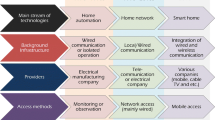Abstract
A smart home, also referred to as connected homes, is a house equipped with sensors that enable its occupants to remotely control home devices and appliances. Smart homes have security benefits, health benefits and allows its user to manage energy efficiently. However, despite the numerous benefits of smart home devices, the number of people using smart homes devices in the UK is low. Therefore, this research aims to investigate the factors that affect the adoption rate of smart homes in the UK from the customer’s perspective using the Unified Theory of Acceptance and Use of Technology (UTAUT) model. A quantitative research method was employed for this study and primary data was collected by snowball sampling through an online survey. 53 responses were collected and analysed using appropriate software. Findings show that the UTAUT constructs (performance expectancy, effort expectancy, social influence and facilitating conditions) influence the behavioural intention of customers to adopt smart homes as well as the actual level of usage. A regression analysis was also carried out to check the influence of moderating factors like the age, gender and smart home awareness on the developed UTAUT model.
Access this chapter
Tax calculation will be finalised at checkout
Purchases are for personal use only
Similar content being viewed by others
References
Bergeron F, Bouchard K, Gaboury S, Giroux S (2018) Tracking objects within a smart home. Expert Syst Appl 113:428–442
Shuhaiber A, Madhal I (2019) Understanding users’ acceptance of smart homes. Technol Soc 58:101110
Hargreaves T, Wilson C, Hauxwell-Baldwin R (2018) Learning to live in a smart home. Build Res Inf 46(1):127–139
Nikou S (2019) Factors driving the adoption of smart home technology: an empirical assessment. Telematics Inform 45:101283
Ghaffarianhoseini A, Ghaffarianhoseini A, Tookey J, Omrany H, Fleury A, Naismith N, Ghaffarianhoseini M (2017) The essence of smart homes: application of intelligent technologies towards smarter urban future. In: Connor AM, Marks S (eds) Handbook of research on creative technologies for multidisciplinary applications. IGI Global, Hershey, pp 334–376
Balta-Ozkan N, Davidson R, Bicket M, Whitmarsh L (2013) The development of smart homes market in the UK. Energy 60:361–372
Moreno V, Ruiz ML, Malagon J, Duboy MA, Linden M (2016) The role of smart homes in intelligent homecare and healthcare environments. In: Dobre C, Garcia N, Mastorakis G, Mavromoustakis C, Goleva R (eds) Ambient assisted living and enhanced living environments. Butterworth-Heinemann, Cambridge, pp 345–394
Mehrotra S, Dhande R (2015) Smart cities and smart homes: from realization to reality. In: International conference on green computing and Internet of Things (ICGCIoT). IEEE, pp 1236–1239
European Commission (2015) Towards an integrated strategic energy technology (SET) plan: accelerating the European energy system transformation. European Commission, Brussels, pp 1–17
HMG (2009) The UK low carbon transition plan: national strategy for climate and energy. HM Government, London
Coughlan T, Brown M, Mortier R, Houghton RJ, Goulden M, Lawson G (2012) Exploring acceptance and consequences of the Internet of Things in the home. In: 2012 IEEE international conference on green computing and communications, pp 148–155
Venkatesh V, Morris MG, Davis GB, Davis FD (2003) User acceptance of information technology: towards a unified view. MIS Quart 27(3):425–478
Rice S, Winter SR, Doherty S, Milner M (2017) Advantages and disadvantages of using internet-based survey methods. J Aviat Technol 7(1):58–65
Malhotra N (2006) Questionnaire Design and Scale Development. In: Grover R, Vriens M (eds) The handbook of marketing research: uses, misuses, and future advances. SAGE Publications, Inc., Thousand Oaks, CA, pp 84–94
Field A (2013) Discovering statistics using SPSS, 4th edn. Sage Publications, London
Compeau DR, Higgins CA (1995) Computer self-efficacy: development of a measure and initial test. MIS Quart 19(2):189–211
Chang A (2012) UTAUT and UTAUT 2: a review and agenda for future research. Winners 13(2):106–114
Ghalandari K (2012) The effect of performance expectancy, effort expectancy, social influence and facilitating conditions on acceptance of E-Banking services in Iran: the moderating role of age and gender. Middle-East J Sci Res 12(6):801–807
Tan PJB (2013) Applying the UTAUT to understand factors affecting the use of English e-learning websites in Taiwan. Sage Open, pp 1–12
Moussaid M, Kammer JE, Analyirs PP, Neth H (2013) Social influence and the collective dynamics of opinion formation. Centre for Adaptive Behaviour and Cognition, Max Planck Institute for Human Development, Berlin
Alshehri MA (2012) Using the UTAUT model to determine factors affecting acceptance and use of e-government services in the Kingdom of Saudi Arabia. Ph.D. thesis, Griffith University. Available at: https://www120.secure.griffith.edu.au/rch/file/1c7cab3e-da14-452a-8379-95387756bd56/1/Alshehri_2013_02Thesis.pdf. Accessed on 07 Jan 2020
Phichitchaisopa N, Naenna T (2013) Factors affecting the adoption of healthcare information technology. EXCLI J 12:413–436
Hayes AF (2018) Introduction to mediation, moderation, and conditional process analysis. A regression-based approach, 2nd edn. Guilford Press, London
Wang Y-S, Wu M-C, Wang H-Y (2009) Investigating the determinants and age and gender differences in the acceptance of mobile learning. Br J Edu Technol 40(1):92–118
Wu M-Y, Yu P-Y, Weng Y-C (2012) A study on user behaviour for I pass by UTAUT: using Taiwan’s MR as an example. Asian Pac Manag Rev 17(1):91–111
Khechine H, Lakhal S, Pascot D, Bytha A (2014) UTAUT model for blended learn: the role of gender and age in the intention to use webinars. Interdisc J E-Learning Learn Objects 10:33–52
Author information
Authors and Affiliations
Corresponding author
Editor information
Editors and Affiliations
Rights and permissions
Copyright information
© 2021 The Author(s), under exclusive license to Springer Nature Singapore Pte Ltd.
About this paper
Cite this paper
Oyinlola Ayodimeji, Z., Janardhanan, M., Marinelli, M., Patel, I. (2021). Adoption of Smart Homes in the UK: Customers’ Perspective. In: Kumar, N., Tibor, S., Sindhwani, R., Lee, J., Srivastava, P. (eds) Advances in Interdisciplinary Engineering. Lecture Notes in Mechanical Engineering. Springer, Singapore. https://doi.org/10.1007/978-981-15-9956-9_3
Download citation
DOI: https://doi.org/10.1007/978-981-15-9956-9_3
Published:
Publisher Name: Springer, Singapore
Print ISBN: 978-981-15-9955-2
Online ISBN: 978-981-15-9956-9
eBook Packages: Intelligent Technologies and RoboticsIntelligent Technologies and Robotics (R0)




